Inevitably the busy hurricane season this year is getting blamed on global warming:
But first of all, let’s get one thing clear – there was not a record number of hurricanes this year in the Atlantic.
There were 13 hurricanes, compared to 15 in 2005:
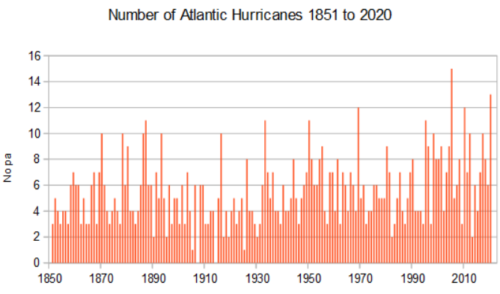
It is true that there were more named storms, which include tropical storms as well as hurricanes, this season than in any other year, but this is quite meaningless.
Over the years, reporting practices have drastically changed, so that more storms are spotted and named now.
As NOAA explains:
There has been a very pronounced increase in the number of tropical storms and hurricanes in the Atlantic since the late-1980s.
Existing records of past Atlantic tropical storm numbers (1878 to present) in fact do show a pronounced upward trend, correlated with rising SSTs (see Figs. 1 and 9 of Vecchi and Knutson 2008).
However, the density of reporting ship traffic over the Atlantic was relatively sparse during the early decades of this record, such that if storms from the modern era (post-1965) had hypothetically occurred during those earlier decades, a substantial number would likely not have been directly observed by the ship-based “observing network of opportunity.”
We find that, after adjusting for such an estimated number of missing storms, there is a small, nominally positive upward trend in tropical storm occurrence from 1878-2006. But statistical tests reveal that this trend is so small, relative to the variability in the series, that it is not significantly distinguishable from zero (Figure 2).
Thus the historical tropical storm count record does not provide compelling evidence for a greenhouse warming-induced long-term increase.
Additionally, if one explores the tropical cyclone database for the Atlantic (HURDAT) more carefully, as was described by Landsea et al (2009), one notices that there has been a very substantial increase in the number of short-duration tropical storms (storms lasting less than two days), while those storms whose duration exceeds two days have not shown a statistically significant increase since the late-19th Century (particularly if they are adjusted for likely missing storms) – see Figure 1 above.
We are unaware of a climate change signal that would result in an increase of only the shortest duration storms, while such an increase is qualitatively consistent with what one would expect from improvements with observational practices.
Thus, we interpret the increase of short duration storms as further evidence for a spurious increase in Atlantic tropical storm counts since the late-19th Century.
All of this applies to hurricanes just as much as storms. We now spot short-lived hurricanes, which in the past would have been counted as just storms.
Dr. Neil Frank, who was Director of the US National Hurricane Center from 1974 to 1987 goes further, maintaining that many of the storms now named would not have been in his day.
He makes two particular complaints about current methods:
1) Many named storms are actually winter storms, not tropical storms. He states that the first six tropical storms this year would not have been counted in his time.
2) Nowadays the NHC rushes to name a storm, simply based on wind speeds. His team would have waited until the central pressure dropped to confirm that it really was a tropical storm and not just a thunderstorm. This often explains why named storms are often so short-lasting now.
When we compare this year’s hurricane tracks with some other busy years, such as 1961 and 1969, the absence of mid-ocean storms in the latter years is immediately clear:
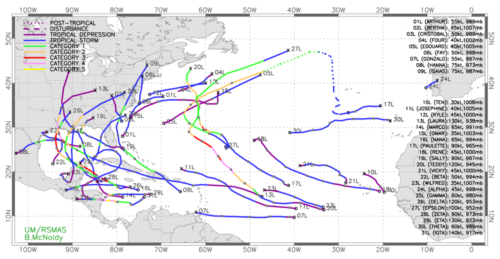
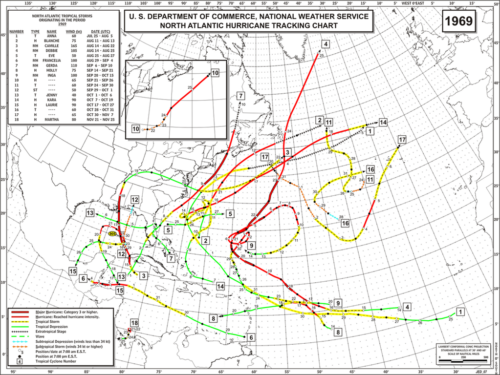
This year, there have been seventeen tropical storms – that is between 39 and 74 mph. Yet in 1961 there were just three and in 1969 six. Yet 1969 saw twelve hurricanes, only one less than this year, and 1961 had eight.
It is absurd to suppose that all storms were recorded in the 1960s.
When we look at major hurricanes, those of Cat 3 and over, a totally different picture emerges:
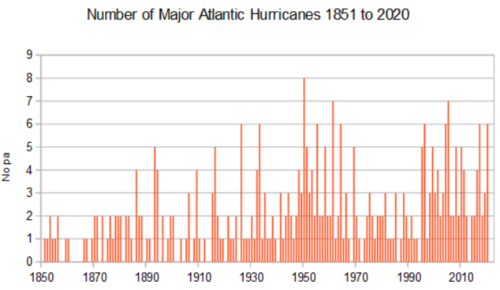
his year, there have been six such hurricanes, below the record of eight seen in 1950 and seven in 1961.
This data clearly implies that hurricanes are getting less intense on average. But is that right, given that global warming theory says the opposite? Or is it just that we spot many more smaller hurricanes now?
This chart shows a clear cyclical pattern, which NOAA explains:
Of course, if hurricanes really were becoming more frequent because of climate change, we would see it in the global trends.
But we don’t:
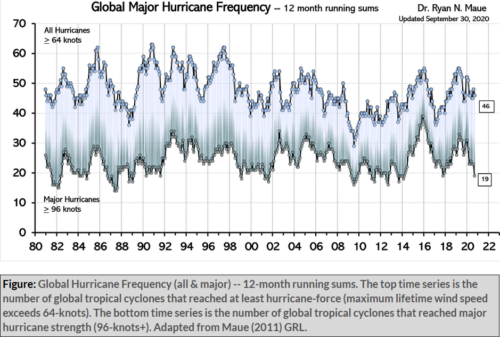
In reality, we only have reliable data on Atlantic hurricanes since the satellite era began in the 1970s. But the 1970s and 80s also coincided with the cold phase of the AMO. Making comparisons now both misleading and meaningless.
What is absolutely clear from the data, however, is that since the AMO warm phase began in 1995, there has been little or no trend in hurricane activity.
Read more at Not A Lot Of People Know That


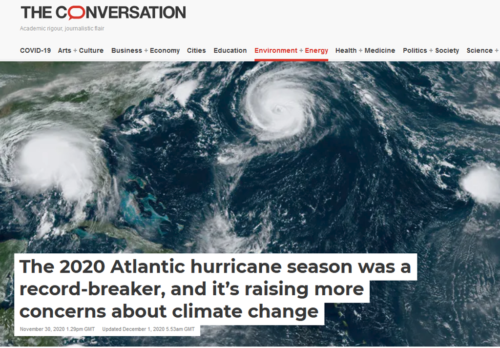



















The worst Hurricane to hit America was the Galveston Hurricane in 1900 it was also called Issac’s Storm
The north atlantic cyclone basin where tropical cyclones are called hurricanes,is just one of 6 cyclone basins. The impact of agw on tropical cyclones can only be assessed in terms of a long term trend of more than 30 years in total accumulated cyclone energy for all 6 basins. This information cannot be found in a single basin much less a single season in a single basin.
https://tambonthongchai.com/2019/11/14/hurricane-obsession/
the naming of storms of any kind has kicked into high gear after the TV network The Weather Channel began to name snowstorms and windstorms in the US winter season a few years ago after NBC took over the television side of the company. It has become a weather-porn channel since that time because precious little up to date weather information is broadcast anymore, the vast majority of the day is insipid pre-packaged videos pushing a leftist climate panic. Sadly this has infected the NHC so they have become ersatz entertainers as well.
We just have some people who will blame everything from Burnt Toast to a major storm on Global Warming an demand we all must live in Grass Huts Yes modern enviromentalism breeds insanity and stupidity
Weather related deaths have dropped from levels ten times those of today over the last one hundred years. While population has increased by nearly three fold. The deadliest hurricane in history made landfall in Galveston, Texas in 1904. It killed 6,000 to 10,000 people. Nothing has come close since. World wide weather related deaths have dropped from 500 thousand a year one hundred years ago to only fifty-six thousand today. That’s what’s important. Not some television generated imaginary climate crisis.